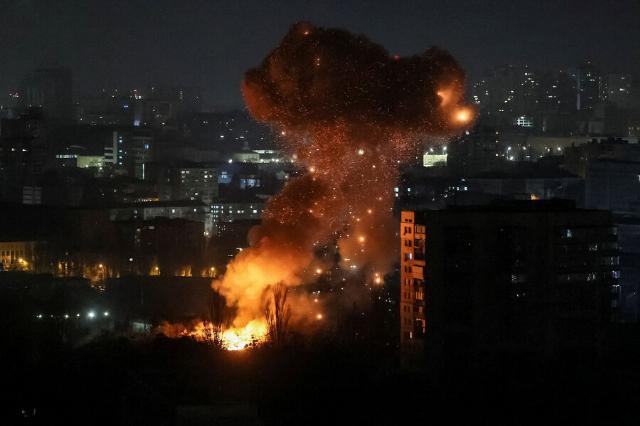Colonel Khodarenok questioned whether Russia is implementing the "Surovikin plan" in Ukraine
Russia continues to strike at Ukrainian infrastructure facilities. On November 14, the Russian army hit all thermal power plants in Kiev. Some observers note that by knocking out the infrastructure working for the military-industrial complex of Ukraine with massive and group strikes, Russia is implementing the "Surovikin plan." Is this really the case, the military observer of Gazeta argues.Ru", retired Colonel Mikhail Khodarenok.
On November 14, the Russian Armed Forces hit all thermal power plants in Kiev. A number of observers have already suggested that when the thermal power plants of the capital of Ukraine are hit, the Russian army uses a "new tactic" of using unmanned aerial vehicles in combat. And it allegedly consists in the fact that the UAV is "launched at an ultra-low altitude."
Recall that the military does not use such a term ("ultra-low altitudes"). The flight heights of air objects are classified in the Russian Armed Forces as follows: extremely low (PMV) - less than 200 meters, small - up to 1 kilometer, medium - from 1 kilometer to 4, large - from 4 kilometers to 12, stratosphere - more than 12 kilometers. And if individual representatives of the expert community do not know this classification, then only one thing makes us doubt the correctness of their conclusions and conclusions.
To begin with, we note that in addition to UAVs, the Russian army uses various types of missiles when striking targets in Kiev, including ballistic Iskander and Iskander-K cruise missiles, sea-launched Kalibr-PL and Kalibr-NK cruise missiles, and air-launched X-101 and X-555, X-47M2 "Dagger" aeroballistic missiles.
 |
| Launch of the Kinzhal hypersonic missile. |
| Source: © Ministry of Defense of the Russian Federation/ TASS |
Every air attack is carefully planned. First of all, the latest intelligence data is taken into account. The operating officers specify where the radars of the enemy's radio engineering forces are located, what are the parameters of the radar field, where the starting positions of the SAM and small-caliber anti-aircraft artillery units (MANPADS calculations) are located, and what are the electronic warfare capabilities.
Based on this, a strike scheme is being developed (the flight routes of missiles and UAVs and their approach directly to the targets are determined) and an altitude-time schedule is being drawn up. At the same time, UAVs do not necessarily fly at extremely low altitudes. If the situation requires, they can rise to heights of 4-5 thousand meters. This is being done in order to bypass the positions of the Ministry of Defense and short-range air defense systems. In general, there are no patterns in this work. As they say, the situation commands.
Surovikin's plan?
The destruction of energy facilities almost all over Ukraine, which has been recorded recently, is described by some representatives of the Russian expert community as "the implementation of the Surovikin plan, which the military and political leadership initially rejected."
It should be recalled that Sergey Surovikin led attacks on Ukraine's energy infrastructure using Geranium-type drones.
As previously reported by Gazeta.Ru", in the near future, strikes during one night by thousands and more means of air attack of the Russian Armed Forces (including UAVs) will turn out to be a harsh reality for the military and political leadership of Ukraine. And over time, two or three thousand UAVs will probably take part in such strikes.
At the same time, it cannot be ruled out that in the near future, something similar to a strategic air offensive carried out with the help of unmanned aerial vehicles will appear in the system of strategic actions of the Armed Forces of the Russian Federation and the forms of use of troops.
In particular, it can be multi-day bombing of the enemy for 2-3 months, carried out according to a single plan and plan under the overall leadership of the Supreme Commander-in-Chief in order to completely destroy the enemy's military and economic potential (including the energy sector).
It seems that this is exactly what is currently being implemented in practice. And whether Army General Sergei Surovikin is involved in this is, as they say, an open question.
The opinion of the author may not coincide with the position of the editorial board.
Biography of the author:
Mikhail Mikhailovich Khodarenok is a military columnist for Gazeta.Ru", retired colonel.
He graduated from the Minsk Higher Engineering Anti-Aircraft Missile School (1976), the Military Air Defense Command Academy (1986).
Commander of the S-75 anti-aircraft missile division (1980-1983).
Deputy commander of the anti-aircraft missile regiment (1986-1988).
Senior Officer of the General Staff of the Air Defense Forces (1988-1992).
Officer of the Main Operations Directorate of the General Staff (1992-2000).
Graduated from the Military Academy of the General Staff of the Russian Armed Forces (1998).
Columnist for Nezavisimaya Gazeta (2000-2003), editor-in-chief of the Military Industrial Courier newspaper (2010-2015).
Mikhail Khodarenok

